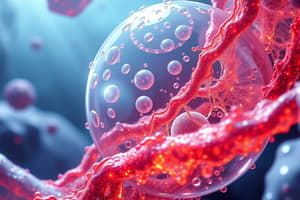Podcast
Questions and Answers
Which of the following liquids showed maximum leaching of pigments from beet root slices?
Which of the following liquids showed maximum leaching of pigments from beet root slices?
- Formaldehyde (correct)
- Ice cold water
- Distilled water
- Alcohol (methanol) (correct)
Beet root slices placed in distilled water show leaching.
Beet root slices placed in distilled water show leaching.
False (B)
What is the purpose of using a cork borer in the procedure?
What is the purpose of using a cork borer in the procedure?
To take out cylindrical pieces of beet root.
The membrane surrounding the vacuole is called the ______.
The membrane surrounding the vacuole is called the ______.
At what temperature does the control experiment for membrane permeability take place?
At what temperature does the control experiment for membrane permeability take place?
What was used to wash the beet root slices before the experiment?
What was used to wash the beet root slices before the experiment?
What causes the membrane permeability to alter according to the experiment's conclusion?
What causes the membrane permeability to alter according to the experiment's conclusion?
Match the test tube with the corresponding liquid and its observation:
Match the test tube with the corresponding liquid and its observation:
Flashcards are hidden until you start studying
Study Notes
Materials Required
- Fresh clean beet root for the experiment
- Knife for slicing beet root
- Cork borer to extract cylindrical pieces
- Test tubes for holding liquid samples
- Spirit lamp for heating materials as needed
- Ice for cooling
- Test tube stand to secure test tubes during observation
- Pipette for measuring liquids
- Beaker for containing test tubes in water
- Distilled water to control sample conditions
- Methanol, formaldehyde, and acetone to test different solvent effects
Membrane Theory
- Cell membranes are thin, elastic partitions separating protoplast from surroundings.
- Eukaryotic plant cells possess plasma membranes and tonoplasts around vacuoles.
- Membranes exhibit selective permeability, affected by temperature, injury, toxic substances, and leaching.
Experimental Procedure
- Wash the beet root thoroughly to remove contaminants.
- Use a cork borer to obtain uniform cylindrical pieces, each approximately 5mm thick.
- Rinse the pieces to eliminate traces of anthocyanin, the pigment responsible for purple color.
- Prepare six marked test tubes (A to F) with specific liquids:
- Test tube A: 10ml distilled water (control).
- Test tube B: Ice cold water.
- Test tube C: Boiled water.
- Test tube D: Alcohol (methanol).
- Test tube E: Formaldehyde (formalin).
- Test tube F: Acetone.
- Immerse two or three beet root slices in each test tube.
- Maintain temperature: test tube B in ice water, test tube C in boiled water.
- After 15 minutes, shake each test tube and observe the color change due to anthocyanin leakage.
Observations and Results
- Control (Distilled Water): No color change, no leaching.
- Ice Cold Water: No color change, no leaching.
- Boiled Water: Purple color indicates leaching.
- Methanol: Dark purple signals maximum leaching.
- Formaldehyde: Dark purple shows maximum leaching.
- Acetone: Purple color indicates leaching.
Conclusion
- Distilled and ice cold water yielded no membrane permeability changes at room temperature and low temperatures.
- Boiled water resulted in pigment leakage, suggesting increased permeability.
- Alcohol and formalin caused maximum pigment leakage, highlighting significant membrane damage.
- Some leaching also occurred with acetone.
Precautions
- Use fresh, clean beet root for reliable results.
- Ensure slices are uniform in size for consistency.
- Maintain equal liquid volumes across test tubes for comparability.
- Shake test tubes thoroughly for accurate color observation.
Studying That Suits You
Use AI to generate personalized quizzes and flashcards to suit your learning preferences.




